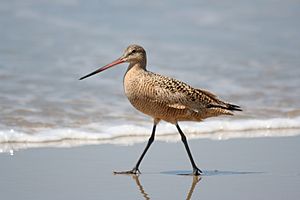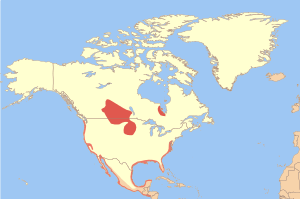Marbled godwit facts for kids
Quick facts for kids Marbled godwit |
|
|---|---|
 |
|
| Conservation status | |
| Scientific classification | |
 |
|
| Range of L. fedoa Breeding Range Non-breeding Range | |
| Synonyms | |
|
The marbled godwit (Limosa fedoa) is a large shorebird. It's usually the biggest of the four types of godwit birds.
Contents
What Does a Marbled Godwit Look Like?
Marbled godwits are quite large birds. They can be about 40–50 cm (16–20 in) long, which is like the length of your forearm! Their long beaks are about 8–13 cm (3.1–5.1 in) long. Their wings can spread out to 70–88 cm (28–35 in) wide. They usually weigh between 240 to 510 g (8.5 to 18.0 oz).
Adult godwits have long, blue-grey legs. Their beaks are pink, very long, and curve slightly upwards with a dark tip. Their neck, chest, and belly are light brown. They have darker stripes on their chest and sides. Their backs are speckled and dark. When they fly, you can see bright cinnamon-colored feathers under their wings!
Where Do Marbled Godwits Nest?
Marbled godwits build their nests on the ground. They usually choose spots with short grass.
What Do Marbled Godwits Eat?
These birds look for food by poking their long beaks into mudflats or marshes. They also search for food on beaches. They mostly eat insects and small sea creatures like crabs and shrimp. They also eat parts of water plants.
How Do Marbled Godwits Behave?
When the ocean tide is low, marbled godwits are busy eating. If they are in short grass, they might pick up insects they see. When the tide comes in, they often rest. They sometimes sleep standing on one leg. They tuck their beak into their body while they rest.
Why Are Marbled Godwits Important?
Marbled godwits faced problems in the past. Many were hunted in the late 1800s, which made their numbers drop. Their population grew back a bit after that. However, their numbers have gone down again recently. This is because their natural homes are being used for farming.
Types of Marbled Godwits
There are two main types, or subspecies, of the marbled godwit:
- L. f. beringiae: This type breeds in the northern part of Alaska Peninsula.
- L. f. fedoa: This type breeds in Canada and the U.S..
Marbled Godwit Migration
Marbled godwits travel long distances. They breed in three different areas and follow their own special routes. Most of them live in the middle of North America. Others live in eastern Canada and the Alaska Peninsula.
Where Do Marbled Godwits Spend Winter?
The largest winter homes for these birds are along the Atlantic, Pacific, and Gulf coasts of the U.S. and Mexico.
Migration Routes
Godwits that breed in the western U.S. and Canada fly through a stopover site in Utah. They then arrive at their winter homes in Mexico and the Caribbean. Birds from eastern Canada fly across the U.S. They stop along the Gulf of California and Mexico. Godwits from North and South Dakota spend their winters on the coast of Georgia.
The Bear River Migratory Bird Refuge in Utah is a very popular stopover spot. Many godwits rest there in the spring and fall during their long journeys.
Gallery
-
Feeding on mudflat at low tide, Elkhorn Slough
-
Marbled godwits feeding, Point Reyes National Seashore, California
-
Sleeping at Balboa Peninsula, Newport Beach, California.
See also
 In Spanish: Picopando canelo para niños
In Spanish: Picopando canelo para niños








